Water shortages along with energy crises and other realities of modern living have taught us valuable lessons about conserving our priceless resources. And in our gardens, we Californians have pioneered sustainable approaches that are beautiful as well as more appropriate to our Mediterranean climate.
Visit a nursery this month, and you’ll see plants no one had heard of a generation ago. They come from the Mediterranean, Australia, South Africa, California’s wild places, and plant breeders greenhouses. They’re plants that need less water and care — familiar staples such as lavender, countless succulents, natives, lawn alternatives and many more.
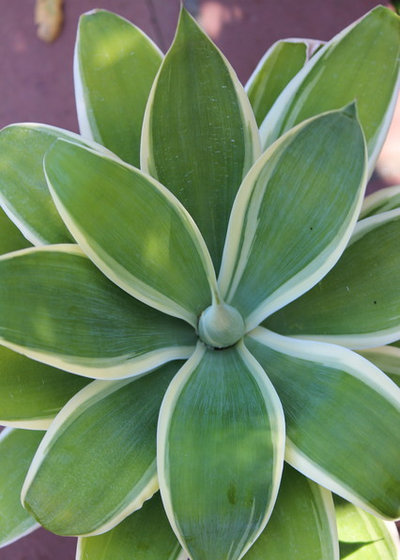 See what steals the shows.
See what steals the shows. A recent San Francisco Flower & Garden Show was loaded with the new breed of climate-appropriate plants. One of the most eye catching was
Agave attenuata ‘Ray of Light’, with white-trimmed, light green leaves in sculptural symmetry. Young plants, about a foot across in gallon-size nursery containers, are ready made for a terra-cotta pot displayed on a patio table.
Botanical name: Agave attenuata ‘Ray of Light’ (also called variegated foxtail agave)
USDA zones: 9 to 11 (find your zone)
Water requirement: Light
Light requirement: Full sun or partial shade
Mature size: 4 to 5 feet tall and 8 feet wide
Growing tips: For container growing, use a soil mix, commercial or your own, formulated for cactus and succulents. This agave will eventually reach 5 feet tall and 8 feet wide, so be prepared to transplant it into the ground in a year or two.
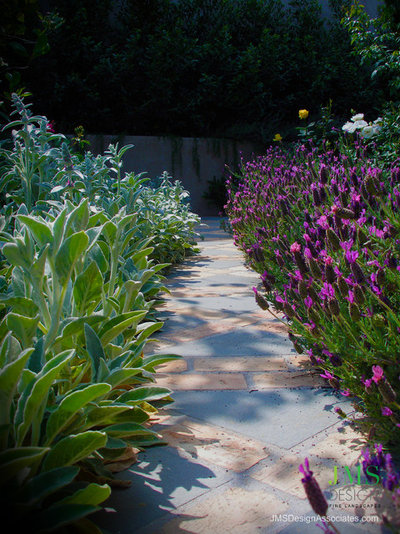
JMSDesignAssociates
Landscape with lavender. There are many reasons to grow lavender: the beauty of the purple flowers and their fragrance, the gray color of the cushiony foliage, the bees and butterflies that are attracted. Lavender also is one of our most dependable, low-maintenance landscape plants.
Among many uses: Mass plants as a ground cover. Edge a walk (trim plants formally if you want that look). Edge a border. Mix in a border. Grow in a pot. Plant underneath roses.
Choose from many lavender
(Lavandula) species and varieties, depending on desired size, growth habit and intended use. Here are just a few of many options:
- Lavandula stoechas, or Spanish lavender, shown: deep purple flowers; up to 30 inches tall; for borders, pots and cottage gardens
- Lavandula angustifolia, or English lavender. 'Hidcote Blue': 2 feet tall, mounding; for mass planting, spotted in borders. 'Blue Cushion': compact growth to 18 inches; low edging.
- Lavandula intermedia 'Grosso': very fragrant; compact growth to 3 feet; for hedges, edging
- Lavandula dentata, or French lavender: long bloom season; 2 to 4 feet tall; for hedges, edging
- Lavandula minutolii, or fernleaf lavender: on the small side, to 2 feet; good for pots
Botanical name: Lavandula spp
USDA zones: 5 to 9 (some species less hardy). Not good in hot, humid climates.
Water requirement: Light
Light requirement: Full sun
Mature size: 2 to 3 feet tall and wide, and bigger
Growing tips: Make sure the soil drains well. Control the size and shape by shearing back the plant (by as much as half) after flowering. When the plants become dry and woody looking, it's time to replace them. Some types can spread seeds and become invasive; eradicate young plants promptly.
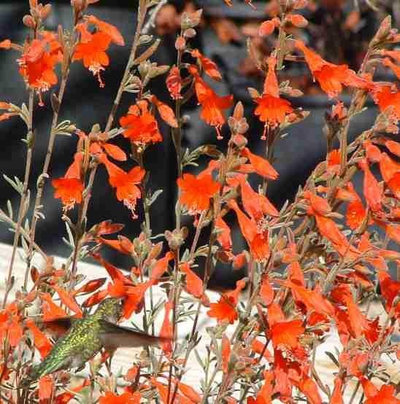
Las Pilitas Nursery
Go for one in from the wild. Until a few years ago, the only place I remember seeing California fuchsia
(Zauschneria californica) was 7,000 feet high near Echo Summit, as patches of red blazing through cracks in gray granite boulders. Today you can see California fuchsia at your neigborhood nursery (Monrovia, a big wholesaler, is one that grows it). California fuchsia has been tamed, losing most of its scraggly, wild look but not its bright color and toughness. It's a dependable long-blooming summer perennial for dry sunny spots, especially slopes. Hummingbirds love it.
Botanical name: Zauschneria californicaUSDA zones: 6 to 9
Water requirement: Light
Light requirement: Full sun
Mature size: Less than 1 foot to 4 feet tall and up to 4 feet wide, depending on variety
Growing tips: A number of varieties have been developed; 'Ghostly Red', with silvery gray foliage, is notable. Make sure the drainage is quick. Trim the plant back and remove dry foliage in fall.
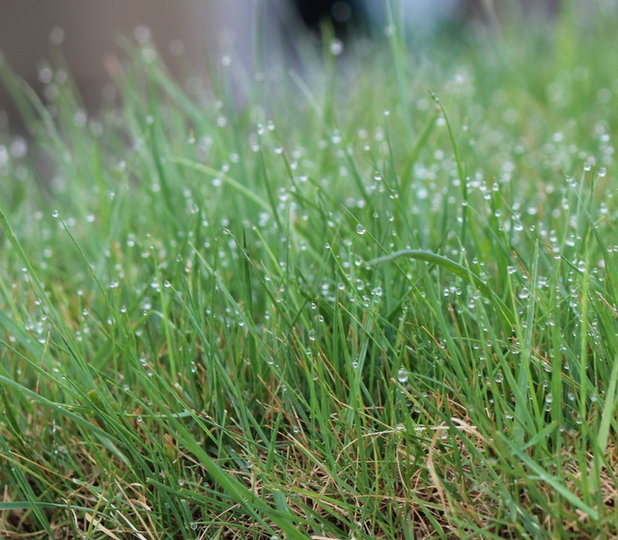 Try this instead of guzzling grass.
Try this instead of guzzling grass. If you're considering planting a new lawn or replacing an old one, consider the water-saving, less-disease-prone alternatives to traditional lawn grasses that came to California generations ago when we aspired to look like England or New England. Several California native grasses now available as sod are worth a close look. Here are two that the growers claim need 50 percent less water than conventional lawns.
- Native bentgrass, shown, has the looks of a fairly conventional lawn grass. It can be mowed to a low height and withstands family wear and tear. Left to grow naturally and unmowed, it can grow into a graceful meadow. It's good in shade.
- Native Mow Free is a mix of several types of fescue grasses that takes some shade as well as full sun. It can be mowed for a regular turf look or left unmowed for a shaggy, lumpy look. It's best to mow it at least a couple times a year. It works well on a slope but is not considered a good play lawn.
Considering that a new lawn is a big deal, try to check out examples of grass choices that work in your area. Your local nursery may have a demonstration of native and other grasses. Make sure you like the texture, color and overall looks and durability. A helpful reference is
The American Meadow Garden: Creating a Natural Alternative, by John Greenlee.
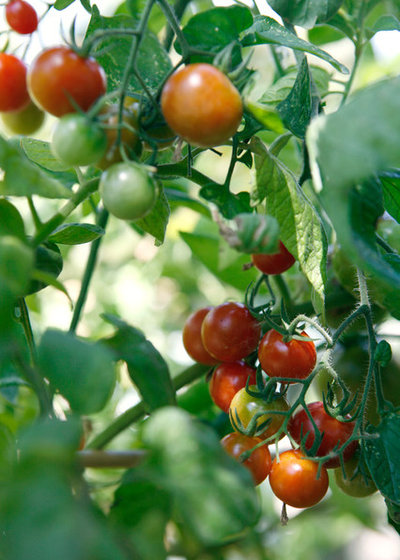
Margie Grace - Grace Design Associates
Test out dry farming for tomatoes. The most intensely flavored tomato you pick up at a late summer farmer's market is apt to have been grown by a process called dry farming. This is not so much about water saving but is a way to concentrate flavor in the ripe fruit. It works!
Want to experiment with dry farming this year? The basic method of some dry-farming growers is to withhold water after transplanting tomato seedlings, forcing roots to go deep for water. That system makes me nervous. But there's a more conservative approach. Try it along with tomatoes grown conventionally as a backup.
Start this month (in warmest climates) or next month with
Early Girl, Sungold, Sweet 100 or another suitable variety. If your soil isn't moist, soak the ground first. Dig an extra-deep planting hole and set seedlings at a depth where the stems will be buried up to the first leaves. Water deeply and regularly for several weeks or longer. Stop normal watering when the fruit starts to show. Withhold water unless the plant starts to wilt or shows other signs of thirst. There's a lot to this technique. For more detailed advice, download this guide from the University of California, Davis.
Even if you can't go all the way with dry farming, there's a good lesson: You'll have tastier tomatoes if you don't overwater.
See the Houzz guide to growing tomatoes
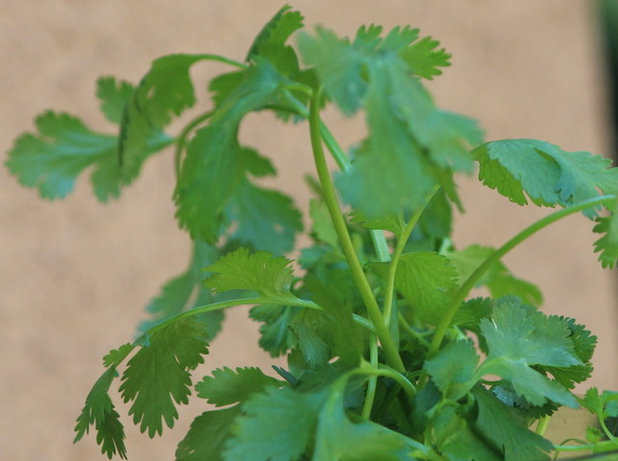 Prep for Cinco de Mayo.
Prep for Cinco de Mayo. An essential ingredient of many Mexican and Asian dishes,
cilantro is easy to grow and so quick that you can plant it in early April and have leaves for guacamole by Cinco de Mayo — and for the next few months. Just remember that 1. This is an expendable, short-lived annual — easy come, easy go; and 2. The herb's enemy is hot weather, which causes it to bolt to seed.
Start seeds or nursery seedlings in pots or the ground (a vegetable garden or even a flower border), in full sun or partial shade in hot climates. Keep the soil moist. Seeds will sprout in a week or so. Start cutting leaves for the kitchen when plants are 3 or 4 inches tall; even if you don't need the leaves, trim the plant weekly to keep new growth coming.
To grow a continuous crop, sow seeds every few weeks. When the plants go to seed too quickly, consider the season over. Wait to plant again when the weather cools off in fall or next spring.
More cool-weather crops and how to grow them
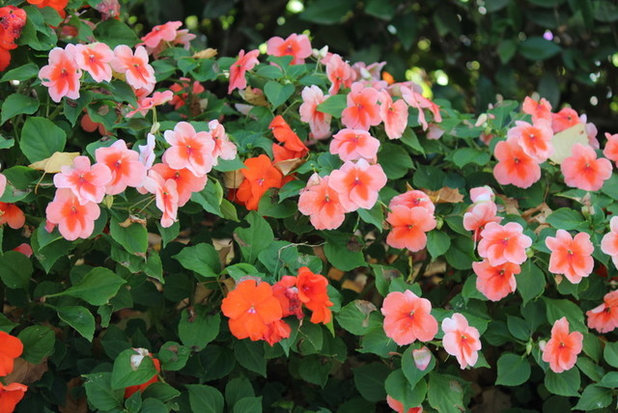 What Else to Do in April in Your California Garden
What Else to Do in April in Your California Garden
Almost everything's growing actively, and there are probably more things to plant, prune and protect than you can handle — this month usually offers more garden enjoyment and action than any other time of year.
Plant annual flowers. Except in cool coastal and mountain areas, fill pots and borders with heat lovers, such as
marigolds, lobelia and
petunias. For shady spots the old reliable (and, yes, overused)
impatiens, shown here, can't be beat — it will keep blooming until Thanksgiving or longer.
Plant perennial flowers. For blooms this summer and summers to come, set out sun-loving, unthirsty types suited for our dry season:
coreopsis, sage, penstemon.
Plant warm-season vegetables. Wait until the air and soil have warmed up in your area (inland valleys are already plenty warm enough) to set out tomatoes and other heat lovers, such as peppers and eggplants. These are easy to start now, in most climates, from seeds or seedlings:
beans, beets, carrots, chard, corn, melons, squash. See more about growing summer crops
Choose and plant roses. Peak bloom time this month offers the chance to pick the color you want from container-grown nursery plants. Watch for signs of aphids on buds and new growth. See 6 deliciously fragrant roses
Plant herbs. Try herbs in pots or a bed near the kitchen.
Thyme and
oregano are easy. Provide full sun and a quick-draining soil mix.
Fertilize. Almost everything benefits from a complete food this month. Give
camellias, azaleas and
rhododendrons an acidic fertilizer after bloom. Start your lawn on a monthly feeding program or follow the schedule on the label.
Watch for pests. Aphids in particular like juicy new spring growth. Start by blasting them with water from the hose before you move on to organic pest controls.
What's going on in your California garden? We'd love to see a photo!





